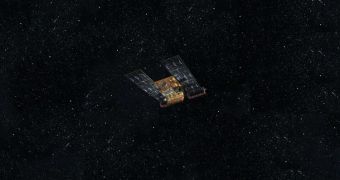Following a successful “burn to depletion” maneuver, one of the most enduring missions NASA sent to space finally came to an end yesterday, March 25. The Stardust spacecraft sent its last transmission to Mission Control at 4:33 pm PDT (2333 GMT).
The comet-hunting probe had a very rich career, which spanned over more than 12 years, of which 8 and a half were during active mission. Over the years, it visited three comets, and carried out a sample-return mission as well.
Even in death, it provided experts with the necessary data to refine computer models predicting how much fuel each space mission would need to compete its objective. The probe was managed by experts at the Pasadena, California-based Jet Propulsion Laboratory (JPL).
“Stardust has been teaching us about our solar system since it was launched in 1999. It makes sense that its very last moments would be providing us with data we can use to plan deep space mission operations in the future,” says JPL Stardust-NExT mission manager Tim Larson.
He explains that, during yesterday's maneuver, the spacecraft was instructed to fire its main thrusters until there was no fuel left in the tanks. As it did so, the probe sent back telemetry data that showed experts just how much fuel it had.
Scientists can now compare these amounts to those their computer models of the mission predict should remain. The results will help predict fuel demands for future missions more accurately.
The “burn to depletion” maneuver took place as Stardust was flying some 312 million kilometers (194 million miles) away from Earth, a position it got to after flying by its last target ever, comet Tempel 1.
This milestone in its mission took place on February 14, 2011. It concluded a prolonged missions, during which the spacecraft visited the comet Wild 2 (in 2004), and return a canister containing samples back to Earth (in 2006).
Even further back, in 2002, it carried out a flyby of asteroid Annefrank, which is a part of the inner asteroid belt. The structure is located between the orbits of Mars and Jupiter, and also contains the dwarf planet Ceres and the huge asteroid Vesta.
“Stardust motors burned for 146 seconds” during the depletion maneuver, said yesterday Allan Cheuvront, who is the program manager for Stardust-NExT at Lockheed Martin Space Systems Company.
“We'll crunch the numbers and see how close the reality matches up with our projections. That will be a great data set to have in our back pocket when we plan for future missions,” he added.
From the time it launched, Stardust traveled more than 5.69 billion kilometers (3.54 billion miles).
“This kind of feels like the end of one of those old Western movies where you watch the hero ride his horse towards the distant setting Sun – and then the credits begin to roll. Only there's no setting sun in space,” Larson says.

 14 DAY TRIAL //
14 DAY TRIAL //